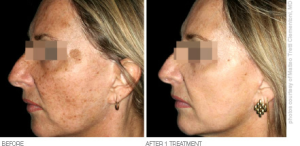More Youthful Skin With Laser Skin Resurfacing
 The skin is subject to many damaging effects, especially as we age and our skin loses collagen and elasticity and begins to form wrinkles around the eyes, mouth and jawline. Years of battling acne can also take a toll on our skin, even years after the acne has disappeared leaving acne scarring in its place. It can be frustrating trying to even out the skin tone, keep wrinkles at bay and battle fine lines as they appear more rapidly than ever and generally speaking, creams and ointments aren’t able to provide significant, long lasting results toward creating a more youthful appearance.
The skin is subject to many damaging effects, especially as we age and our skin loses collagen and elasticity and begins to form wrinkles around the eyes, mouth and jawline. Years of battling acne can also take a toll on our skin, even years after the acne has disappeared leaving acne scarring in its place. It can be frustrating trying to even out the skin tone, keep wrinkles at bay and battle fine lines as they appear more rapidly than ever and generally speaking, creams and ointments aren’t able to provide significant, long lasting results toward creating a more youthful appearance.
Those who are seeking noticeable, long lasting results in ridding their skin of fine lines, creases, wrinkles and scarring may consider turning to laser skin resurfacing as a means for transforming the surface of their skin to create a more even tone, smoother surface and fresher appearance. Laser skin resurfacing couples CO2 and lasers to pinpoint damaged areas of the skin, burn off dead skin cells on the skin’s outer layer, and encourage new skin cell growth that that is less damaged and more refined.
Laser skin resurfacing begins with an application of a topical anesthetic cream on the area of treatment to help dull the sensation while the laser is used to smooth out the skin. The procedure itself is virtually painless as the technician then glides the laser over the skin; the laser beam heating and vaporizing the outermost layer of the skin while keeping the surrounding areas of skin untouched.
Depending on the size of the damaged skin, laser skin resurfacing may take just minutes or up to an hour per session. Patients experiencing more severe acne scars, wrinkles or lines may need to undergo at least a couple laser skin resurfacing sessions in order to see optimal results while others can enjoy significant results after just one sessions.
Post treatment patients can expect to experience what feels like a mild sunburn on their treated areas, a sensation which should subside as the area begins to heal. Healing periods will vary patient by patient and will once again be dependent on how large the area of treatment covers.
There are some risks associated with laser skin resurfacing including possible changes in the skin’s pigmentation where treated, possible burns and possible scarring. Your doctor can help educate you on the possible risks and benefits and how laser skin resurfacing might be the best option for improving your skin.
